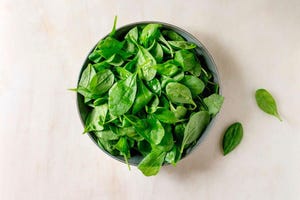
The FODMAP Diet Can Help With Digestive Issues. Here's How It Works - CNET
If you suffer from chronic digestive issues, you may have come across the term “FODMAP” — especially regarding something called the low-FODMAP diet. Is low-FODMAP a new trend or diet craze? Is there any proof to back up the low-FODMAP diet? And before we get to any that; what even are FODMAPs and could they really be causing or exacerbating your tummy troubles? I spoke to Victoria Albina, a holistic nurse practitioner and breathwork facilitator, to get the 4-1-1 on FODMAPS.
Read more: How Your Gut Affects Your Mental Health
What are FODMAPs?
The term FODMAP is an acronym for fermentable oligo-, di-, mono-saccharides and polyols. In short, they are fermentable carbohydrates found in many of the foods we commonly eat. Albina explains that FODMAPs are “naturally occurring short-chain carbohydrates that are generally not well absorbed in the small intestine. For most of us, these foods help prevent digestive symptoms by feeding the good bugs that make up our intestinal or gut microbiomes.”
For a person with a healthy digestive system, FODMAPs are nutritionally beneficial and often high in fiber, which further help optimize digestion.
Which foods are high in FODMAPs?

Garlic is a high-FODMAP food.
CNET
Many of the foods we commonly eat contain FODMAPs. According to Albina, “Many fruits, vegetables, beans, legumes, pulses, dairy, gluten and nongluten grains [and] some artificial sweeteners contain FODMAPs.”
While most beans, wheat and dairy products are high in FODMAPs, nuts and seeds are considered low-FODMAP. Cruciferous vegetables like broccoli, Brussels sprouts and cauliflower are high-FODMAP, as well as members of the onion family, including garlic. The University of Virginia has a comprehensive list of high- and low-FODMAP foods (PDF).
When are FODMAPs problematic?
Foods high in FODMAPs are beneficial for most people because of their nutritional content. But, Albina explains that for those with sensitive digestion or digestive disorders like irritable bowel syndrome and small intestine bacterial overgrowth, FODMAPs can be disruptive to their system. Consuming FODMAPs with one of these conditions can cause discomfort including abdominal pain, gas and bloating.
Is the low-FODMAP diet for everyone?

Some nuts are high-FODMAP, including cashews and pistachios.
Shutterstock
The low-FODMAP diet is only for individuals who are experiencing digestive distress and is not a trendy new diet everyone should try out. “I do not recommend a low- or no-FODMAPs diet if you don’t have a diagnosed reason to follow such a restrictive plan,” Albina says.
Albina warns, though, that even for individuals with IBS and SIBO, the low-FODMAP diet should be a short-term approach. “It’s important for balanced nutrition to have foods like beans, broccoli, berries, onions and garlic in your diet. Without these foods, your gut microbiomes can be severely impacted, and there are no studies showing the benefit of a low- or no-FODMAP diet for longer than a few months, maximum,” she said.
If you want to try a low-FODMAP diet, test it out for a short period of time and then start to reintegrate FODMAPs once your digestive symptoms dissipate. Albina cautions long-term use of “such a diet can not only negatively impact your microbiome but it can lead to a loss of oral tolerance, meaning you can become sensitive to more foods in the long run.”

Not all veggies are low-FODMAP, but most leafy greens (like spinach) are.
Getty Images
Additionally, being on such a restrictive diet can lead to other health concerns, she explains. “Frankly, I think this diet can be a set-up for disordered eating, easily. I tell folks to test out different FODMAP foods and to keep in small quantities of any FODMAP-containing food they can tolerate, don’t just cut it out because it’s on a list. Learn to listen to your body!”
Should you try a low-FODMAP diet?
If you think a low-FODMAP diet may be helpful in overcoming gut issues, talk to your doctor to see if it’s the best protocol for you.
“It’s important to work with a functional medicine provider or naturopath to diagnose and properly treat the underlying condition, not just to avoid whole food groups,” Albina says. “The goal of this diet is to reduce symptoms so you can do the things that help you not need the diet — finding and treating the bacterial overgrowth, parasites and more; getting your nervous system regulated so you have good motility; and healing your relationship with your body, your health and your digestion.”
The bottom line: The low-FODMAP diet may be helpful in the case of specific medical situations but is not something worth exploring just as a health craze. Otherwise, enjoy your broccoli and garlic — your body and taste buds will thank you.
<div data-id="" data-cy="shortcodeListicle" data-location="LIST" data-position="1" edition="us" superlative="A Revolutionary Plan for Managing IBS and Other Digestive Disorders" imagegroup="{"alt":"low-fodmap-diet.png","caption":"
","credits":"Amazon","imageData":{"id":"b680c177-6a45-4a11-8bd7-a0e33c964fab","title":"low-fodmap-diet","filename":"low-fodmap-diet.png","path":"https://www.cnet.com/a/img/ECmlKspIc9QZY5d41F1yXz96pUQ=/2020/03/05/b680c177-6a45-4a11-8bd7-a0e33c964fab/low-fodmap-diet.png","caption":"
","size":82952,"width":533,"height":433,"dateCreated":{"date":"2020-03-05 18:44:00","timezone":"UTC","timezone_type":3},"dateUpdated":{"date":"2020-03-05 18:44:06","timezone":"UTC","timezone_type":3},"needsModeration":false,"mimeType":"image/png","deleted":false,"credits":"Amazon","alt":"low-fodmap-diet.png","restricted":false,"startDate":null,"endDate":null,"preferred":false,"watermark":false,"doNotCrop":false,"doNotResize":false,"primaryCollection":null,"vanityUrl":null,"notes":null,"crop":null,"cropGravity":0,"preservedRegion":null,"isNew":false,"keywords":[],"primeColor":null,"typeName":"content_image"},"uuid":"b680c177-6a45-4a11-8bd7-a0e33c964fab","imageAltText":"low-fodmap-diet.png","imageCaption":"
","imageCredit":"Amazon","imageDoNotCrop":false,"imageDoNotResize":false,"imageWatermark":false,"imageFilename":"low-fodmap-diet.png","imageDateCreated":"2020/03/05","imageWidth":533,"imageHeight":433,"imageParallax":"","imageCrop":"","imageEnlarge":false}” overridecaption=”
” overridecredit=”Amazon” data-key=”cnetlisticle__4a6c8db2-731c-4140-8ee9-e9090c0182d7″ position=”NaN” contenttype=”Explainer” pagelayout=”Default – Article Page w/ original publish date” showdetails=”true” class=”c-shortcodeListicle g-border-thin-light-top g-inner-spacing-bottom-medium g-inner-spacing-left-large g-inner-spacing-right-large g-inner-spacing-bottom-xlarge g-outer-spacing-bottom-large g-border-thin-light-bottom g-border-thin-light-right g-border-thin-light-left”>
Looking for more information? This complete guide to the low-FODMAP diet will help you navigate the popular nutrition plan known to alleviate IBS and other digestive disorders.
This article was originally written for Chowhound by Sara Weinreb.

